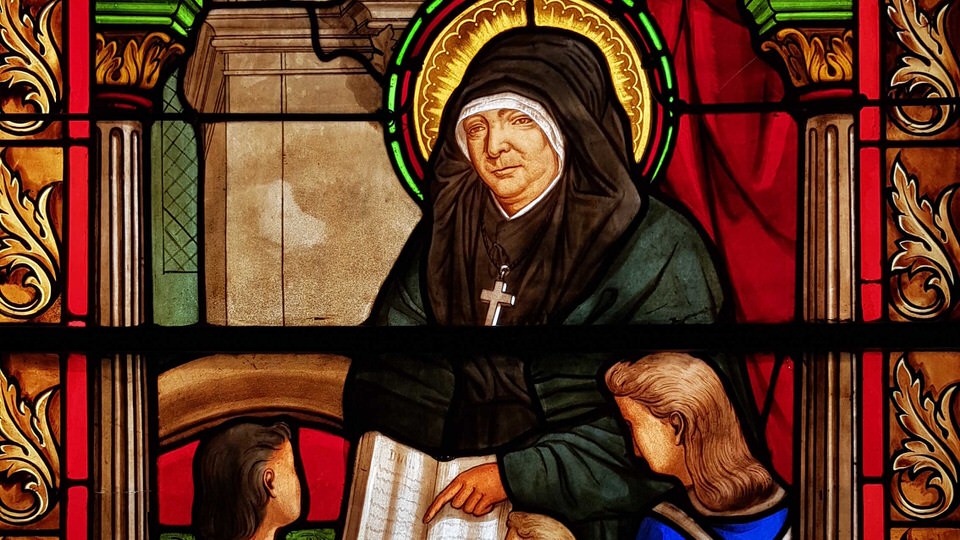



Saint Marie Rivier: The Woman-Apostle
Kristina Glicksman
Friday, May 13, 2022

Stained glass window depicting Marie Rivier in the chapel of the motherhouse of the Sisters of the Presentation of Mary in Bourg-Saint-Andéol, France (Source: Wikimedia Commons)
“So what is the secret of Marie Rivier’s zeal? One is struck by her boldness, her tenacity, her expansive joy, her courage. Her life demonstrates well the power of faith in a simple upright soul which surrenders itself entirely to the grace of baptism. She relied on God.” – Pope John Paul II, from the beatification homily for Blessed MarieOn May 15, Pope Francis will canonize ten holy people we currently address by the title of blessed. Among them is a diminutive French woman who showed great tenacity and courage during a time of religious persecution, a woman whose soul was so on fire with a passion for sharing Christ with others that Pope Pius IX – who gave her cause for canonization the go-ahead in 1853 by approving her as “Servant of God” – reportedly called her the “Woman-Apostle”. A childhood marked by suffering and prayer Anne-Marie Rivier was born on December 19, 1768, in the village of Montpezat-sous-Bauzon in the mountains of southern France. When she was only 16 months old, little Marinette (as she was known to her family) had a terrible accident. Falling off a high bed, she fractured her hip and ankle. Crippled and unable to walk, she used her hands to drag herself around on her back. Every day, Marinette’s mother brought her poor crippled child to church. Every day for four years, she prayed before a statue of the Pietà – one sorrowing mother to another. And every day, the little child lying on the mat learned from this simple yet powerful witness of her mother’s faith and grew herself in devotion to our Blessed Mother, entrusting herself to her care. And she made a promise that if she were ever to be cured, she would devote herself to the education of children. On September 8, 1774, the feast of Mary’s Nativity, little Marie unexpectedly found she could walk, and she received a second, further healing three years later on August 15, 1777, the feast of Our Lady’s Assumption. However, some of the effects of her early disability remained with her, and also suffering from rickets, as an adult, she only reached a height of 4’4”. Keeping her promise Marie Rivier lived during a time of great turmoil. In 1789, social and economic pressures erupted in the French Revolution. No one was unaffected by the changes which swept across the country, including a systematic campaign to remove the Catholic Church and Christianity itself from every part of French existence. At the time it began, Marie was running a school in her hometown, having been rejected by a nearby convent due to her poor physical health. During a time of anti-religious sentiment and persecution, including the expulsion of religious congregations from the country, Marie became a rock in the midst of the storm, leading secret prayer services when there was no priest to say Mass and continuing to catechize the local community. When the authorities confiscated the school building in 1794, Marie moved her school to the nearby village of Thueyts, where on November 21, 1796, she and four other women dedicated themselves to God and became the first Sisters of the Presentation of Mary (the feast of Mary's presentation in the Temple being celebrated on November 21). It is a great testament to the courage and faith of this woman that she would found a new religious order in such an unwelcoming time and place. And a testament, too, to the strength of her witness of faith that so many women followed her. Just a year later, when the first members made their religious profession, they had already more than doubled in number. Dedicated to the education and religious formation of youth, this fledgling order grew rapidly after the end of the French Revolution. Their work was welcomed and supported by the local hierarchy and even received the blessing of Pope Pius VII. By the time of Marie’s death in 1838, the sisters had opened nearly 150 schools, and they continue to work in 19 countries on five continents, working with children, young people, and the marginalized. Miracles Given Blessed Marie Rivier’s ministry to children, it should come as no surprise that the recipients of her two approved miracles were a 7-year-old child and an unborn baby. On February 3, 1938 – the 100th anniversary of Marie’s death – young Paulette Dubois was miraculously cured of the effects of mercury poisoning, leading to Marie’s beatification in 1982. The miracle for her canonization took place in 2015 in the Philippines when a fetus experiencing life-threatening swelling (edema) was cured through Blessed Marie’s intercession. Angel Marie Vier Albaracin Degamo was born later that year. Possible patronage St. Marie Rivier would be a good patron for catechists who work in hostile anti-Catholic, anti-Christian, or anti-religious environments. Whether they risk their jobs, their status, or even their lives for the sake of bringing Christ to others, they can find in the boldness and zeal of the Woman-Apostle an inspiration and a friend.
“I wish you an ardent love for Jesus Christ, and I pray to him that he might be your light, your strength, your rampart, your rock and your citadel.” – Marie Rivier
Related Articles:
<<
SUPPORT LABEL
$50
$100
$150
$250
OTHER AMOUNT
DONATE
Receive our newsletters
Stay Connected
Receive our newsletters

Stay Connected







